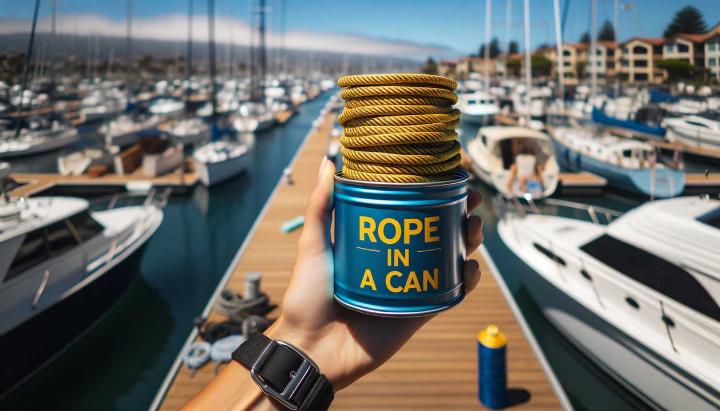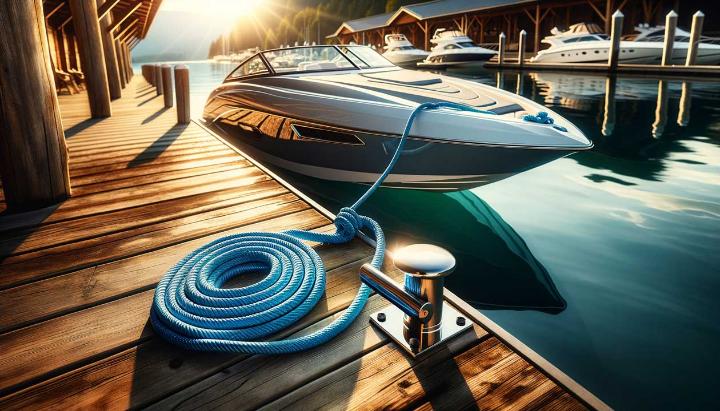Have you ever found yourself in a precarious docking situation, desperately fumbling with tangled ropes as your boat drifts dangerously close to the pier? Enter the game-changing innovation of rope in a can - a revolutionary solution that's transforming the way boaters approach docking.
Imagine effortlessly dispensing the perfect length of rope, free from knots and tangles, right when you need it most. That's the power of rope in a can. This ingenious device not only simplifies your docking process but also enhances safety and efficiency on the water.
In this essential guide, we'll explore the ins and outs of using rope in a can for docking, including the advantages of 3 in rope and 1 in nylon rope options. Whether you're a seasoned sailor or a weekend warrior, mastering this innovative tool will revolutionise your boating experience. Get ready to sail into a future where docking stress is a thing of the past!
Understanding Rapid Rope: The Ultimate Portable Solution
Have you ever found yourself in a bind, desperately needing a sturdy rope but struggling with tangled messes or bulky coils? Enter the game-changing innovation of rope in a can, also known as Rapid Rope. This ingenious solution has revolutionised the way we store, transport, and use rope for various applications, including docking.
What is Rope in a Can and How Does It Work?
Imagine a compact canister that fits snugly in your hand, containing an impressive 120 feet of high-strength cord. That's the essence of rope in a can. The clever design allows you to dispense just the right amount of rope without the hassle of knots or tangles. As a boating enthusiast myself, I've found this product to be a true lifesaver during docking manoeuvres.

The unique dispensing mechanism allows for smooth, tangle-free deployment. Simply pull the rope from the canister, and it feeds out effortlessly. When you're done, the remaining rope stays neatly stored inside, ready for your next use.
Key Features and Benefits of Rapid Rope
- Impressive strength: With a test strength of 1100 lbs, this rope can handle most docking scenarios with ease.
- Compact storage: The canister design takes up minimal space in your boat, leaving more room for other essential gear.
- Versatility: While perfect for docking, Rapid Rope is a multi-use product suitable for camping, cargo securing, and various outdoor activities.
- Tangle-free operation: Say goodbye to frustrating knots and time-consuming untangling sessions.
As featured on Shark Tank, Rapid Rope has quickly gained popularity among boating enthusiasts and outdoor adventurers alike. Its innovative design addresses common pain points associated with traditional rope storage and use.
Have you ever struggled with tangled ropes during a crucial docking moment? Share your experiences in the comments below, and let's discuss how rope in a can could be the solution you've been searching for.
Choosing the Right Rope for Your Boat
When it comes to docking your boat safely and efficiently, selecting the right rope is crucial. As a seasoned sailor, I've learned that the perfect rope can make all the difference between a smooth berthing experience and a frustrating ordeal. Let's dive into the world of marine ropes and explore how to choose the best one for your vessel.
Types of Boat Ropes and Their Uses
Before we delve into the specifics of rope in a can, it's essential to understand the various types of ropes available for boating. Each material has its unique properties, making it suitable for different applications:
- Nylon: Known for its strength and elasticity, nylon is perfect for dock lines and anchor rodes.
- Polyester: Offers excellent UV resistance and minimal stretch, ideal for halyards and sheets.
- Polypropylene: Lightweight and floats on water, making it great for water ski tow ropes.

Factors to Consider When Selecting Boat Rope
When choosing the right rope in a can for your boat, consider these crucial factors:
- Boat size: Larger boats require thicker ropes to handle the increased load.
- UV resistance: Look for ropes designed to withstand prolonged sun exposure.
- Rope construction: Double braid offers a good balance of strength and handling, while three-strand is more economical.
- Breaking strength: Ensure the rope's breaking strength is appropriate for your boat's size and weight.
For most recreational boats, a 3/8-inch (9.5mm) to 1/2-inch (12.7mm) diameter rope is suitable. However, larger vessels may require ropes up to 3/4-inch (19mm) in diameter.
Focus on 3 in Rope and 1 in Nylon Rope Options
When it comes to rope in a can solutions, 3-inch and 1-inch nylon ropes are popular choices. The 3-inch rope offers excellent versatility for various boating tasks, while the 1-inch nylon rope provides superior strength for heavy-duty applications.
Here's a quick comparison:
- 3-inch rope: Ideal for general-purpose use, easy to handle, and store in a compact can.
- 1-inch nylon rope: Perfect for larger boats or when extra strength is required, such as in rough docking conditions.
Remember, the key is to find the right balance between strength, handling, and storage convenience. Have you considered using rope in a can for your boating needs? Share your thoughts and experiences in the comments below!
Essential Techniques for Using Rope While Docking
As a seasoned boater, I've learned that mastering proper docking techniques is crucial for a safe and stress-free experience on the water. Let's dive into some essential methods for using rope effectively during the docking process, with a special focus on how rope in a can can simplify your approach.
Proper Approach and Positioning for Docking
The key to successful docking lies in your initial approach. I always remind fellow boaters to:
- Slow down and assess: Approach the dock at a slow, controlled speed, taking note of wind and current conditions.
- Use the elements: Let the wind or current assist you in manoeuvring your boat parallel to the dock.
- Communicate clearly: Ensure your crew understands their roles and use hand signals or verbal cues for coordination.
With rope in a can, you'll find it easier to make quick adjustments during your approach, as the rope is readily accessible and tangle-free.
Tying Effective Knots for Secure Docking
Once you're in position, securing your boat properly is paramount. Here's where your knot-tying skills come into play:

The bowline knot is my go-to for creating a secure loop. Here's a quick step-by-step guide:
- Form a small loop in the standing end of the rope.
- Pass the working end up through the loop.
- Wrap it around behind the standing end and back down through the small loop.
- Tighten by pulling on both ends.
Remember, when using rope in a can, you can easily dispense the exact length needed for your knots without excess rope getting in the way.
Mastering Line Throwing for Efficient Docking
Accurate line throwing is a skill that can make or break your docking experience. Here are some tips I've picked up over the years:
- Coil properly: Create loose, even coils in your non-throwing hand.
- Aim carefully: Focus on a specific target on the dock or to a person assisting you.
- Use a smooth motion: Throw with a fluid, underhand motion for better accuracy.
With rope in a can, you'll find that the smooth dispensing action allows for easier coiling and throwing, reducing the risk of tangles or snags. To further refine your docking technique, consider exploring the best dock lines for unmatched strength and durability.
Safety tip: Always wear non-slip shoes and keep your hands clear of the gap between the boat and dock when handling ropes during docking.
By mastering these techniques and incorporating the convenience of rope in a can, you'll find that docking becomes a smoother, more efficient process. Have you tried using rope in a can for docking? Share your experiences in the comments below!
Maintaining and Storing Your Rope: Essential Care Tips
As a long-time boating enthusiast, I've learned that proper rope care is not just about extending the life of your equipment—it's about ensuring your safety on the water. Let's dive into some essential techniques for maintaining and storing your rope in a can, keeping it in top-notch condition for all your maritime adventures.
Proper Rope Storage Techniques
The way you store your rope can make or break its longevity. Here are some tried-and-true methods I've picked up over the years:
- Cool and dry is key: Store your rope in a well-ventilated area away from direct sunlight and moisture. I've found that a dedicated rope bag or container works wonders in protecting against the elements.
- Avoid chemical exposure: Keep your rope away from harsh chemicals, including cleaning agents and fuel. Even small amounts can weaken the fibres over time.
- Loose is better than tight: Resist the urge to coil your rope tightly. Instead, store it loosely to prevent kinks and maintain its flexibility.

Rope Maintenance for Longevity
Regular maintenance is crucial for keeping your rope in prime condition. Here's my routine for rope care:
- Clean after each use: Rinse your rope with fresh water to remove salt, sand, and debris. For tougher grime, use a mild soap solution and rinse thoroughly.
- Dry completely: Always air dry your rope before storage. I like to drape it over a railing in a shaded area—never use direct heat, as it can damage the fibres.
- Regular inspections: Run the rope through your hands, feeling for any unusual bumps, soft spots, or frayed areas. Pay special attention to areas that experience the most wear, like splices and knots.
For more comprehensive advice on extending the life of your rope, learn how to maximize lifespan with reinforced nylon rope ends. Remember, a well-maintained rope is a reliable rope. Don't skimp on care—your safety depends on it!
When to Replace Your Rope
Even with the best care, ropes have a finite lifespan. Here are some signs that it's time to retire your trusty rope:
- Visible damage: Fraying, cuts, or severe discolouration are clear indicators that your rope's integrity is compromised.
- Age: As a general rule, I replace my ropes every 3-5 years, depending on usage and storage conditions.
- Stiffness or unusual flexibility: If your rope feels overly stiff or unusually stretchy, it's likely time for a replacement.
Safety Tip: When in doubt, replace your rope. The cost of a new rope is insignificant compared to the potential risks of using a compromised one.
By following these maintenance and storage tips, you'll not only extend the life of your rope but also ensure it's ready to perform when you need it most. For detailed guidance on choosing and maintaining your ropes, read our article Essential Tips for Choosing and Maintaining Boat Anchor Ropes. Have you got any rope care tips of your own? Share them in the comments below—I'd love to hear your experiences!
Docking your boat safely requires the right tools, and the innovative rope in a can offers a hassle-free solution. This guide dives into how rope in a can simplifies docking with its compact, tangle-free design. Featuring versatile options like the 3 in rope for general use and the 1 in nylon rope for heavy-duty tasks, you'll learn to choose the perfect rope for your needs. Master proper techniques for deploying, knotting, and maintaining your rope to ensure longevity and safety. Discover the ultimate convenience in docking with a rope in a can, making your boating experiences smoother and stress-free.
Ready to Upgrade Your Docking Experience?
Fill in the form above to get more information or assistance about integrating the right rope in a can into your docking equipment. Our experts are ready to help you make the best choice for a safer, more efficient boating experience.